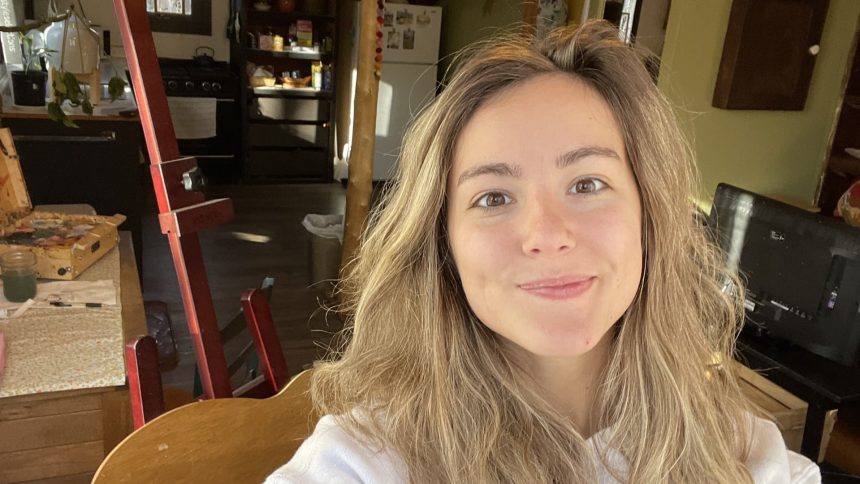The day after AnnMarie Young graduated from the University of Texas at Austin in 2021, she and her best friend moved to Fairbanks, Alaska for the summer.
The 23-year-old artist lived in Alaska for three months before returning to Texas. But Young tells CNBC Make It that the moment she left, she knew she wanted to go back to the Pacific Northwest state.
“Something in my heart just didn’t want to leave Alaska,” she says. “I wanted to prove to myself I could tough it out.”
Young used the money she made from selling her art that summer to buy a van that had already been converted into a tiny home. She packed up, headed toward Alaska, and after a week of driving cross country she arrived.
“I was going slow and taking scenic routes,” she says.
When Young got back to Alaska she lived in her van for a few months before moving into the dry cabin.
AnnMarie Young
Young spent the summer of 2022 living out of her van, but when winter rolled around, she had a decision to make — either go back home to Texas again or find a different living situation there in Alaska.
The artist eventually found a cabin in Fairbanks through word of mouth, but it did come with a catch. The cabin Young was being offered was a dry one — a residential structure without running water. The property did come with an outhouse.
The owner, Mollie Sipe, a retired educator, 71, was renting it out for $500 a month.
Sipe tells CNBC Make It she bought the cabin in 1988. It is one room about 10 feet x 20 feet with a bedroom nook. It includes a kitchen area with a stove and a microwave and a heater that runs on heating oil, which Sipes always fills up before each new tenant.
Young got to see the cabin from the outside, but never got to tour the inside before deciding to accept the rental. Fortunately, it all worked out just fine. “It’s not the dreamy cabin that you imagine but it is really cute on the inside. It was very cozy and perfect for just me at the time,” Young says.
“I had a whole section to do my art stuff and that was the most important thing to me.”
Young’s favorite part of the cabin was that she had a dedicated corner to work on her art.
AnnMarie Young
‘It’s a place for women to take a turn in their lives and jumpstart in Alaska’
Sipe started renting the cabin in the 80s, and her tenants have only ever been to women — a total coincidence but a fact that Sipe loves.
“They always find the next person for me, and it has always been women. That’s sort of the mystique of the ‘Cabin Girls, ‘ as I call them. They have been very dependable that way, so I never have to look,” Sipe says.
“It’s a place for women to take a turn in their lives and jumpstart in Alaska,” she says. “It’s just a way of life that you get to find out what you’re made of, what you can do, and how capable you are.”
After rent, Young’s expenses included 25 cents to fill up three five-gallon water jugs, something she drove into town to do every week and a half or so.
Young admits that one of the biggest issues she had living in the dry cabin was access to internet. The cabin is surrounded by tall trees which made it difficult to get reliable cell and internet connection. She even tried using Starlink at one point, but had to cancel due to inconsistent service.
The dry cabin is about 10 feet by 20 feet and has one room with a kitchen area and a bedroom nook.
AnnMarie Young
Living in a dry cabin meant Young had no plumbing, laundry, shower, washer, or dryer.
She washed her dishes and brushed her teeth in a five-gallon water jug that drained into a bucket underneath and had to be dumped manually.
“Because I was already living van life, transitioning to a dry cabin was a lot easier. I was already living without things that the dry cabin didn’t have, like a shower or bathroom,” Young says. “It took me a week to get used to it, and then it just became my new normal.”
“I’m not a tough person; I didn’t grow up camping and am not a rugged outdoor person, but if I can do it, I think a lot more people can do it,” she added. “It’s all about setting your mind to something,” she adds.
The dry cabin didn’t have running water, so Young would shower in the neighbor’s house a few times a week.
AnnMarie Young
Young was able to take a proper shower at a neighbor’s house every couple of days, and used baby wipes and other products in the dry cabin in between.
“We had a deal setup that I would come and use the shower when they weren’t home because they wanted someone to use the pipes to make sure they didn’t free,” she says.
And when she needed to use the bathroom, Young would throw on a thick robe and slippers and start walking the path to the outhouse in the back. Young was sure to always keep that path clear of snow.
A typical day in Young’s life when she lived in the dry cabin included training her dog, Moose, driving into town to a coffee shop to use the Wi-Fi and work on her website, and hours spent painting.
While some may think living in a cabin in the middle of the woods sounds isolating, Young says she’s never felt more of a sense of community than when she lived there.
“I had such a good group of people in the area that I felt like I was hanging out with friends every night,” she says. “I loved feeling like I was doing something special and tough and that the whole way of life is normalized in the area.”
Young spent almost a year living in the dry cabin before she moved into a one-bedroom apartment in Anchorage.
AnnMarie Young
“You can do it by yourself but it’s a lot harder, so I loved the community aspect of everybody leaning on each other to live that kind of lifestyle,” she adds.
Young lived in the dry cabin for about eight or nine months before she moved into a one-bedroom apartment with her boyfriend in Anchorage, Alaska. The two split a $1450 a month rent payment and while she loves having the extra space, Young admits she misses life back in the cabin and would do it again in a heartbeat.
“I think that we could do it again. I miss the aspect of living in a cabin,” Young says.
“I feel so connected to Alaska since the first summer I came up. I don’t know if I’ll be here forever, but I know it’s where I want to be right now.”
Want to land your dream job in 2024? Take CNBC’s new online course How to Ace Your Job Interview to learn what hiring managers are really looking for, body language techniques, what to say and not to say, and the best way to talk about pay. CNBC Make It readers can save 25% with discount code 25OFF.
Read the full article here




